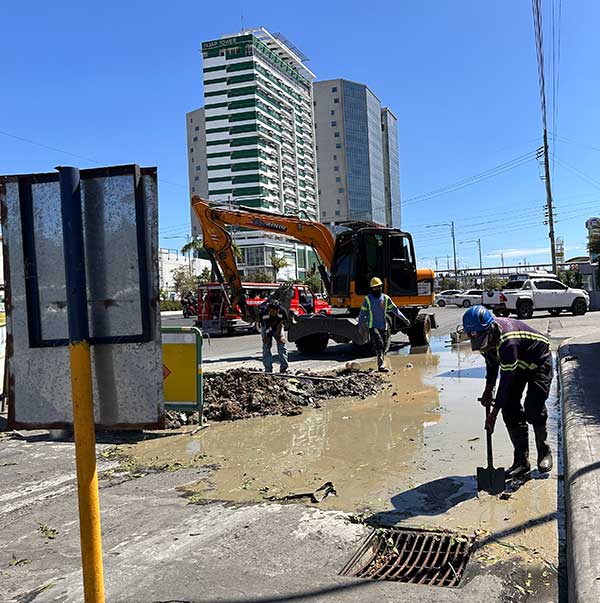
By Joseph Bernard A. Marzan
The Iloilo City government is not on the verge of declaring a state of calamity, as the current heat conditions have not yet crossed the thresholds set by the national government, said the head of the City Disaster and Risk Reduction Management Office (CDRRMO) on Monday.
City officials took the opportunity at the mayor’s regular Monday press conference to address the upcoming dry season expected due to El Niño.
This follows a virtual session hosted by the Local Economic Development and Investment Promotions (LEDIP) Office last Friday, Feb. 23, where the business sector was briefed on the developing situation.
In this briefing, CDRRMO’s Disaster Response Division chief Darwin Papa reported that the city has been experiencing drier conditions since January, based on data from the Philippine Atmospheric, Geophysical, and Astronomical Services Administration (PAGASA).
PAGASA’s data also projected a dry spell by the end of February, escalating to a drought by April and May, with average rainfall potentially decreasing by over 60 percent.
CDRRMO chief Donna Magno reiterated these findings during the press conference, noting that the city government recognizes the issue and is preparing for the possible onset of drought conditions.
“[Iloilo City] has to plan for [the drought], because we know that it will have an impact in various sectors. As early as last year, we have been meeting with members of the Iloilo City DRRM Council and we’ve been discussing mitigation and [are preparing] these measures,” said Magno.
However, she stated that a state of calamity cannot be declared at present, referencing Memorandum Order No. 60 series of 2019 from the National Disaster Risk Reduction and Management Council.
According to this memorandum, a declaration requires at least 15 percent affected population needing emergency assistance and at least 30 percent disruption to livelihood in agriculture, business, and industrial sectors.
“So far, we have not received concerns from the barangays that they do not have accessible water anymore, and the agricultural sector has not been affected yet. So, there have not yet been any indications which will allow us to declare a state of calamity. But the biggest consideration there will be access to water which will be established by the City Environment and Natural Resources Office,” she said.
She added that the City Disaster Risk Reduction and Management Council will also be convening soon to address further mitigation and response measures so that the city would be ready.
WATER DEMAND AND SUPPLY
Aside from engagements with public-private entities Metro Pacific Iloilo Water (MPIW) and South Balibago Waterworks (SBW) which supply water to the city, city government offices have also been exerting efforts to enjoin the private sector in conserving water.
City Architect Regina Gregorio initiated a Drought Forum for contractors, highlighting the increased water consumption during construction activities in the summer season.
“Come summer season, there is an increase in construction activities that would require a higher demand for water, and we have our laborers exposed to the blazing heat of the sun. It is vital for us to inform them and to pique their brains insofar as water management is concerned,” Gregorio said.
“What we have gathered from them is that, during summer season also, they do water impounding, and water management as to how they use the water at the [construction] sites. They’re also adjusting working hours to start early and probably take a longer noon break, so their people would not be exposed to the blazing heat,” she added.
City Environment and Natural Resources Office (CENRO) head Neil Ravena also revealed that reserves from the rainwater harvesting and water impounding facilities at the La Paz Plaza, which can hold up to 12,000 cubic meters (12 million liters) were being depleted.
Water from the said facility is being used by the city government for use in the district plazas and gardens and along the pathways at Benigno Aquino Jr. Avenue (Diversion Road) and Corazon Aquino Avenue (Circumferential Road).
“Diversion Road is badly affected because it is pavement, so the temperature is really high. During our urban heat inventory, we observed that it was one of the hottest areas [in the city], while the [Iloilo River] Esplanade had lower [temperatures]. We’ve seen 57 royal palms dying,” he said.
To this, Gregorio said that they are replicating the impounding and harvesting facilities for the other plazas, and that her office is coordinating with the CDRRMO to identify locations where facilities could be developed as well, in response to not only the El Niño phenomena but also to the city’s continuing urbanization.
Ravena also stated that the Central Philippine University has been providing 11 tankers to augment their existing supply and that they have been looking for other sources for the Garden of Love at the foot of the Nabitasan Bridge in La Paz district.
A CENRO team has also been formed to monitor water extraction and will be providing a report on the situation, to avoid the intrusion of seawater into the deep wells as well as to prevent excessive extraction.
For the agricultural sector, City Agriculturist Iñigo Garingalao stated that they downloaded high-yielding seeds to farmers on time, but also in advance of the drought, since rice had greater water requirements.
There aren’t any effects from the El Niño yet according to Garingalao, but like other offices, they are also monitoring the effects of the phenomena citing the nature of their water use.
“We were trying to chase time for the first cropping to be early, so that they [farmers] can harvest early, and second cropping which needs fewer hectares [of planting] will also be early and would be timed to be harvested in February,” Garingalao said.
Magno said that the CDRRMO is also encouraging village officials to utilize their Barangay DRRM Fund allocations to acquire water impoundment and rainwater harvesting facilities for their own communities, not only for the ongoing phenomenon but also for continued use.




















